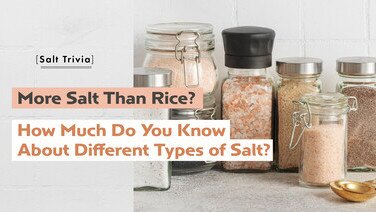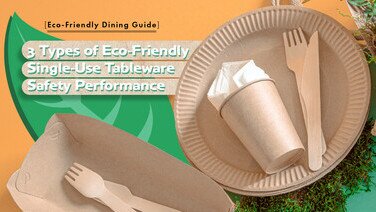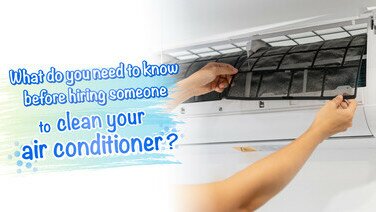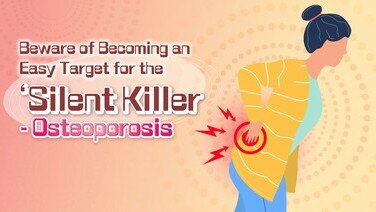Symptoms of COVID-19
According to the "Diagnosis and Treatment Protocol for Novel Coronavirus Pneumonia (Trial Version 4)" issued by the National Health Commission of the People's Republic of China (National Health Commission), the incubation period for COVID-19 infection is generally 3 to 7 days, and the longest no more than 14 days. At the time of onset, main symptoms include fever, fatigue, and dry cough. A small number of patients have symptoms such as nasal congestion, runny nose, and diarrhoea. Severe cases often start to suffer from difficulty in breathing after a week. Critical cases rapidly develop into acute respiratory distress syndrome, septic shock, metabolic acidosis, and coagulation dysfunction. Most patients who eventually pass away are elderly or people with underlying chronic diseases.
The Appearance of Coronaviruses
Coronaviruses are enveloped viruses, that is, the internal proteins and genes of the virus are covered by an external lipid layer. Its surface is covered with spike-like rods that make it look like a crown, hence the name coronavirus. According to the data released by the National Health Commission, the particles of the novel coronavirus are round or oval, with a diameter of 60 to 140 nanometers.
Coronaviruses can cause diseases in human, poultry and livestock, such as respiratory diseases in human and chicken, and enteritis in cattle and pigs, etc., and have certain impacts on public health and the economy. The Severe Acute Respiratory Syndrome (SARS) outbreak in Hong Kong in 2003 and the Middle East Respiratory Syndrome (MERS) in 2012 are both relatively serious diseases caused by coronaviruses.
Proper Wearing of Surgical Masks to Reduce Droplet Transmission
The respiratory secretions of patients infected with coronavirus generally carry the virus. During the patient's coughs, sneezes, and even ordinary conversations, the coronavirus is transmitted through droplets from the mouth and nose, and enters into the body of another person through the eyes, mucous membranes of the nose or mouth. This is the main roue of transmission. During cold winters, people tend to gather indoors to avoid the cold, so coronaviruses are more likely to spread through droplets in winter. Those infected with coronavirus or suffering from a respiratory illness should wear a surgical mask to reduce the risk of droplet transmission to others.
Important notes on wearing masks are as follows:
- Clean your hands before putting on a mask. You may wash them with liquid soap and water, or rub them with alcohol-based hand sanitiser (see the “Hand Hygiene” section for handwashing methods).
- The coloured side faces out and the metallic/ plastic strip faces up. If both sides of the mask are of the same colour, such as white, the side with downward folding pattern should face out.
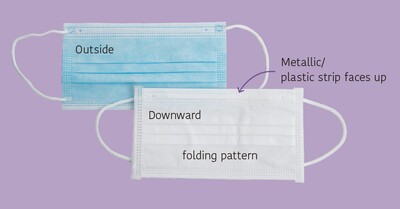
- For ear-loops surgical masks, position the elastic bands around both ears. For tie-on surgical masks, secure ties at the crown of head and at the nape.
- Extend the surgical mask so that the mask covers your mouth, nose and chin completely.
- Mold the metallic strip over both sides of the nose bridge so that the mask fits snugly over the face.
- Try not to touch the mask after wearing it properly.
- When taking off an ear-loops surgical mask, hold both ear loops and take off the mask. For tie-on type, unfasten the ties at the nape first, and then unfasten the ties at the crown of head.
- When taking off the surgical mask, try not to touch the side facing out, as the area might have been contaminated with bacteria or viruses.
- Throw the used surgical mask in to a covered trash can and clean your hands immediately.
- If the mask is damaged or soiled, it should be replaced immediately.
Some common misuses are as follows:
- Wearing the mask inside out
- The mask only covering the mouth while exposing the nose
- The user taking off the mask when speaking, coughing or sneezing
- Keeping masks taken off in clothing pocket for re-use
-
Consumers may refer to the mask test report published by the Council in December 2017 to learn about matters to pay attention to when purchasing and wearing masks.
Pay Attention to Personal Hygiene
The novel coronavirus can be transmitted through contact. A person can be infected through touching contaminated surfaces such as tabletops and door handles, and then touching mucous membranes (that is, eyes, nose, and mouth, etc.). Scientific literature showed that coronaviruses (such as SARS and MERS) can survive for several days on hard surfaces such as that of plastic or metal objects. In dry and cool environments of low temperature and low humidity such as during winters, the survival time of viruses on surfaces maybe even longer. Therefore, you should maintain good personal hygiene. Especially after touching public objects, if you cannot wash your hands thoroughly or clean them using alcohol-based hand rub, do not touch parts such as your eyes, mouth, and nose, etc.
In addition, hands must be cleaned thoroughly with detergent and water when they are visibly soiled, stained with body fluids or respiratory secretions, after using the toilet, after cleaning excrement for children and pets, and before eating and preparing food.
If you have touched public objects (such as escalator handrails, elevator buttons, and door handles, etc.), you may use alcohol-based hand rub to clean your hands in the absence of water.
Handwashing Tips
- Wet your hands and close the tap.
- Apply the detergent, rub your hands to produce rich foam, and spread the foam evenly on your hands. Rub thoroughly for at least 20 seconds (amount of time it takes to sing the English “Happy Birthday” song twice). The rubbing area includes palms, backs of hands, wrists, gaps between fingers, fingers (don't forget the thumbs), fingertips, and nail gaps.
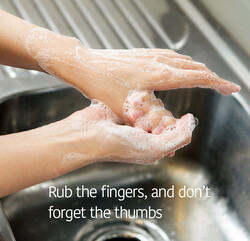
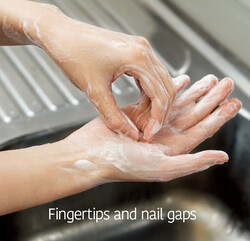
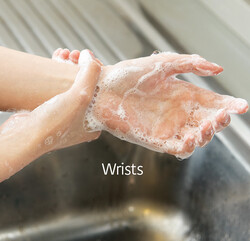
- Rinse hands with clean water to remove lather from hands thoroughly.
- Drying your hands with a paper towel is recommended.
- After washing your hands, avoid touching the faucet directly; consider wrapping the faucet with a paper towel before closing it.
Generally speaking, washing hands with liquid hand soap and clean water is the most important and feasible step to preventing the spread of germs and diseases. However, it is not necessary to use liquid hand soaps and detergents with antibacterial claims. In fact, washing your hands the right way and maintaining good handwashing habits is more important than choosing the type of hand soap. Even if you have chosen a product with antibacterial claims, if you do not wash your hands properly, you will not be able to achieve the expected bactericidal effect. For example, beware of believing that products can instantly remove bacteria from your hands, while ignoring the importance of adequate rubbing during handwashing.
With traditional soap bars, it is generally difficult to achieve a rich foam. When using, your hands must be wet before rubbing. Remember to always pay attention to the hygiene of soap bars and soap boxes to ensure that there is no standing water and avoid microbial contamination caused by water stagnation. In public places, liquid hand soaps would be preferred to avoid cross-contamination.
Can I Wash My Hands with Body Wash or Washing Up Liquid?
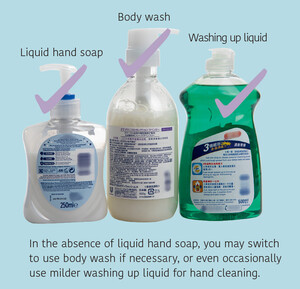
In the absence of liquid hand soap, you may switch to body wash if necessary, or even occasionally use milder washing up liquid for hand cleaning. However, it should be noted that some detergent formulations in the market are alkaline, and if they are used for handwashing for a long time, there is a greater chance of irritating the skin and causing the problem of dryness.
Four Mistakes in Hand Hygiene
- Handwashing time was too short: You should rub for at least 20 seconds after applying detergent or alcohol-based hand rub.
- The amount of alcohol-based hand rub too small: Generally, 3 to 5 ml would be needed to cover all parts of the hands. Also, pay special attention to the expiration date and storage method of the alcohol-based hand rub.
- Insufficient rubbing of every part of the hands, overlooking thumbs, fingertips, and between fingers: Even with foaming hand wash, don't forget to rub well. If there are artificial nails or the nails are too long, the decoration on the artificial nails and the gaps between the nails can easily become a breeding ground for dirt and bacteria. If you wear rings and jewellery, you should also take them off before washing your hands, so that you can clean your hands thoroughly.
- Using water that is too hot, damaging the skin: You should wash your hands with room temperature or lukewarm water is recommended.
Tips for Using Alcohol-based Hand Sanitiser
- In the absence of clean water, you may use alcohol-based hand rub (about 70% to 80% alcohol concentration) or disinfectant wipes to clean your hands.
- Pour the alcohol-based hand rub into the palm of your hand. Using about 3 to 5 ml is recommended. The amount should be enough to cover the palms of both hands, the backs of the hands, the wrists, the gaps between the fingers, the fingers (don't forget the thumbs), and the fingertips.
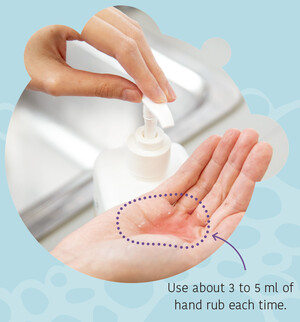
- Rub your hands together for at least 20 seconds after applying, until the alcohol evaporates naturally.
- Ensure that your hands are dry when applying; otherwise the moisture on the skin may dilute the alcohol concentration of the hand rub, which may affect its bactericidal effect.
- If the hands have obvious grease or dirt, the bactericidal effect of alcohol hand rub will be lowered. In the absence of water, consider using a wet towel to wipe off the dirt on your hands, and then use an alcohol-based hand sanitiser.
- Alcohol-based hand rubs are flammable and should be stored properly to avoid direct sunlight or proximity to heat sources.
- If used by infants and young children, ensure that the alcohol-based hand sanitiser on their hands is completely evaporated and that their hands are dry before allowing them to touch food and mouth. The alcohol-based hand sanitiser should be kept out of reach of infants and young children to prevent them from taking it by mistake.
Prevent the Hands from Getting Dry and Cracked: Apply Hand Cream to Protect the Skin's Natural Barrier Function
Frequent handwashing and use of alcohol-based hand rubs can easily dry out the skin of the hands and may eventually lead to skin dermatitis. In fact, in recent months, in order to prevent infection of the novel coronavirus, everyone has been washing their hands frequently. Many people suffer from peeling, cracking, redness, swelling, and itching on the skin of their hands, which not only causes discomfort, but also wounds on the hands. This may also weaken the skin's natural protective barrier function. Therefore, every time after washing your hands, remember to apply hand cream to protect the skin of your hands.
Whether you use hand rub, body wash, or even washing up liquid, be aware that the product may contain potentially allergenic preservatives such as MIT (methylisothiazolinone), CMIT (methylchloroisothiazolinone) and formaldehyde-releasing ingredients (such as 2-bromo-2-nitropropane-1,3-diol, DMDM hydantoin, imidazolidinyl urea, and quaternium-15). People with particularly sensitive skin should read the product ingredient list carefully and avoid using products containing the above ingredients. In addition, those who are allergic to fragrances should avoid choosing products containing fragrances and fragrance allergens.
Paying Attention to Home Hygiene
Some people may work from home. Children do not need to attend classes and stay at home for longer periods of time. Maintaining a hygienic home environment is all the more important to prevent infection and spread of the virus. Try to keep indoor air circulation as much as possible, such as opening windows whenever possible, or using an extractor fan to increase air circulation. In addition, some coronaviruses, including the COVID-19, can also be detected in the faeces of patients, indicating that the virus may be transmitted through faeces. During the SARS epidemic in 2003, the virus in the faeces was airborne through the sewage systems of buildings, which was one of the ways of causing large-scale infection. Therefore, you should clean your home frequently and pay attention to measures to prevent the spread of the virus and reduce the risk of infection. As mentioned above, coronaviruses have a lipid envelope, which makes them fragile. Ordinary cleaning and disinfecting agents are already very effective, such as cleaning hands with alcohol-based hand sanitiser, doing laundry using regular washing powder, or cleaning surfaces using diluted household bleach.
Furniture
- Clean home frequently, especially frequently touched areas, furniture, toys, utensils, toilets, bathrooms and floors. For example, use 1:99 diluted household bleach (that is, 1 part of household bleach containing 5.25% sodium hypochlorite mixed with 99 parts of clean water) to clean non-metallic surfaces daily; then rinse with water and wipe dry. Metal surfaces can be cleaned with 70% alcohol or other detergents that can be used on metal surfaces. The inside and equipment of private cars are also frequently touched areas, and can be cleaned with 1:99 diluted household bleach every day.
- If floors, furniture, clothing, etc. are soiled with secretions or excreta (such as vomit, faeces, or sputum from patients with respiratory diseases), after removing the dirt, use 1:49 diluted household bleach (that is, 1 part of bleach containing 5.25% sodium hypochlorite mixed with 49 parts of clean water) for disinfection. After 10 to 15 minutes, rinse with clean water and dry.
- Since the active ingredients of bleach gradually decrease with time, when purchasing, select the ones that have been produced recently or have a longer validity period. For diluted bleach, the longer it has been stored, the more the decomposition, and the bactericidal ability may be reduced. Diluted bleach should be used within 24 hours to avoid affecting the bactericidal efficacy.
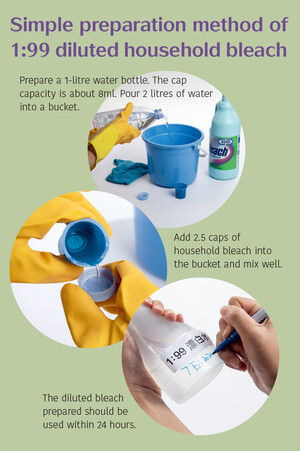
Dust Filter of Electrical Appliances
- Based on the instructions for use of the electrical products, regularly clean the dust filters attached to electrical appliances such as air conditioners, dehumidifiers and air purifiers using suitable detergents. This will help reduce the amount of dust and microorganisms in the indoor air.
Floor
- Clean floors regularly, and increase the frequency as needed. Keep floors dry.
- Keep carpets clean. Vacuum daily and wash them regularly.
- If you have pets, increase the cleaning frequency.
Toilets and Bathrooms
- Toilets should be regularly washed with toilet detergent. Wipe the toilet door handle and the surrounding of the toilet seat with 1:99 diluted household bleach, and keep them dry.
- Ensure that the flushing system is functioning properly. After using the toilet, cover the toilet before flushing to avoid splashing water or contaminating the surrounding environment with microorganisms.
- Prepare enough liquid hand soap and paper towels for cleaning your hands thoroughly.
- As bacteria or viruses may be spread through the drain, make sure that the kitchen sink, wash basin, bathtub and toilet floor drain (U-shaped divider) have sufficient water storage. The Centre for Health Protection recommends that 500ml of clean water be injected every week, to ensure that the air barrier functions effectively.
Pay Attention to the Cleanliness of Mobile Phones, Clothes and Shoes
Apart from frequent cleaning of the home, under the premise of strictly preventing the epidemic, don't be afraid of trouble, and take an extra step in the details of life to help reduce risks. Every time you go out and return to your home, school, or office, you should wash your hands with detergent and water immediately. If you have been somewhere with high-risk, such as a hospital, a clinic, or other densely populated places, it is recommended that you wash your hands, change clothes, shower and wash your hair immediately after returning home, and wash all clothes.
Shoes
- Take off your shoes before entering the door. Depending on your home situation, put your shoes outside the door, or in a shoe rack or shoe cabinet near the door. It is also recommended that you spray the soles with diluted bleach and air dry them before placing them in the shoe rack or shoe cabinet to avoid bringing harmful microorganisms into the house.
- Wash hands immediately after handling footwear.
Wash Clothes Frequently
- Clothes should be washed and changed frequently, and don't place them randomly after returning home to avoid accidental touch by children, which could easily lead to infection.
- When washing clothes using a washing machine, set a higher water temperature of about 50°C to 60°C, which can effectively reduce the activity of coronavirus.
- Thick and heavy coats, sweaters or jackets cannot be washed frequently. They can be placed separately, such as hanging on the terrace/balcony for airing, so as not to contaminate other clothes.
- Depending on the equipment at home, if there is a steam iron, you may use steam to iron coats, etc. The heat will help reduce the number of microorganisms and reduce the risk of infection.
Mobile Phones
- Studies show that mobile phones used daily contain more bacteria than toilet seats, so it is recommended that the surface of mobile phones be regularly cleaned with disinfectant wipes. If there are no disinfectant wipes, wipe with soapy water or diluted detergent solution; then wipe with clean water and dry.
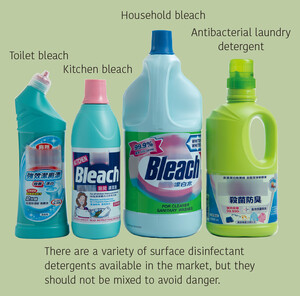
Household bleach can be used to disinfect and sterilise, but the supply of bleach is currently in short supply, so it may not be available, but consumers do not need to worry. There are a variety of special detergents in the market for cleaning different household items. For example, some antibacterial laundry detergents contain hydrogen peroxide, which helps remove microorganisms from clothes. Some kitchen bleaches contain sodium hypochlorite, that is, the active ingredient in bleach but may be at a lower concentration, and can be used to clean kitchen utensils, rags, or countertops. Some toilet bleach products also contain sodium hypochlorite and other chemicals that can be used to clean toilets. Consumers should carefully read the instructions and purposes on the package and use accordingly. This should achieve the purpose of disinfection, cleaning and reduce the risk of infection.
These products may have bleach ingredients, but because the concentration of active ingredients is different from that of bleach, and they may contain other chemicals, they can only be used for the stated purposes. Consumers should not dilute them for use as bleach.
Consumers must pay attention to the fact that most antibacterial detergents contain different chemical substances. Remember not to mix different kinds of cleaning detergents for use. After use, they should be placed in a cool place and out of reach of children to avoid accidents. In addition, some products may be flammable, such as alcohol or alcohol-based hand sanitiser. When using them, there should not be open flames around or people smoking to avoid danger.
Conclusion
If everyone takes appropriate preventive measures, the risk of being infected and spreading the virus will be reduced. This is helpful to themselves, their family members, friends, medical staff, and society. Let’s get through this difficult time together by keeping watch and helping each other.
Source of information (some parts): Dr. Siddharth Sridhar, Clinical Assistant Professor, Department of Microbiology, HKU Li Ka Shi


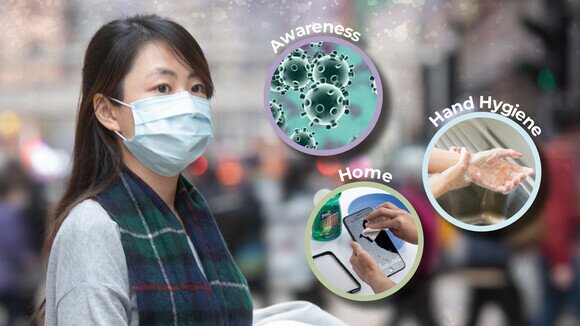




![[Baby Snacks Guide] Who Says Snacks Can’t Be Healthy?](/f/guide_detail/415742/376c212/bb%20snack.jpg)
